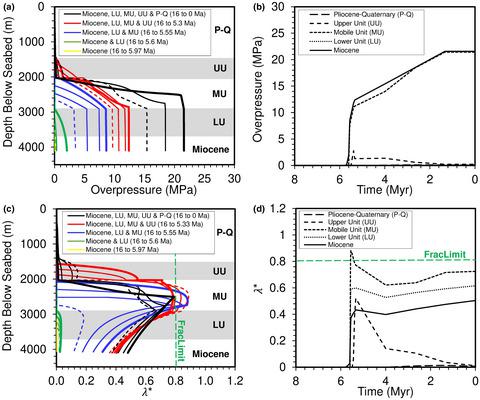当前位置:
X-MOL 学术
›
Basin Res.
›
论文详情
Our official English website, www.x-mol.net, welcomes your
feedback! (Note: you will need to create a separate account there.)
The Messinian Salinity Crisis as a trigger for high pore pressure development in the Western Mediterranean
Basin Research ( IF 2.8 ) Pub Date : 2021-02-08 , DOI: 10.1111/bre.12554 Michael Stanley Dale 1, 2 , Héctor Marín‐Moreno 1, 3 , Ismael Falcon‐Suarez 1 , Carlos Grattoni 4 , Jonathan M. Bull 2 , Lisa C. McNeill 2
Basin Research ( IF 2.8 ) Pub Date : 2021-02-08 , DOI: 10.1111/bre.12554 Michael Stanley Dale 1, 2 , Héctor Marín‐Moreno 1, 3 , Ismael Falcon‐Suarez 1 , Carlos Grattoni 4 , Jonathan M. Bull 2 , Lisa C. McNeill 2
Affiliation

|
Evaporites are typically described as impermeable seals that create some of the world's highest reservoir pressures beneath the salt seal. However, several laboratory studies demonstrate that evaporites can retain open pore spaces that hydraulically connect the sediments above and below them in sedimentary basins. During the Messinian Salinity Crisis (5.97–5.33 Ma), up to 2,400 m thickness of evaporites were rapidly deposited in the Western Mediterranean, which may have generated high pore fluid overpressure in the basin sediments. Here we use one-dimensional numerical modelling to quantify the temporal evolution of overpressure at two distinct locations of the Western Mediterranean, the Liguro-Provençal and Algero-Balearic basins, from the Miocene to Present. We reconstruct the sedimentation history of the basin, considering disequilibrium compaction as an overpressure mechanism and constraining model parameters (such as permeability and porosity) using laboratory experiments and the literature. In the Liguro-Provençal basin the highest overpressure of 11.2 MPa occurs within the halite during deposition of Pliocene to Quaternary sediment, while in the Algero-Balearic basin at the base of the Emile Baudot Escarpment, the highest overpressure of 3.1 MPa also occurs within the halite but during stage 3 of the Messinian Salinity Crisis (5.55–5.33 Ma). In the Algero-Balearic basin an overpressure of 3.1 MPa could have been sufficient to hydro fracture the sediments, which agrees with the development of fluid escape features observed on seismic reflection profiles. In general, our models with evaporite deposition rates above 20 m kyr−1 and permeabilities below 10–18 m2, suggest that high overpressure, approaching lithostatic, can be generated in salt basins.
中文翻译:

墨西拿盐度危机是西地中海高孔隙压力发展的触发因素
蒸发岩通常被描述为不可渗透的密封层,它在盐层密封层下方产生了一些世界上最高的储层压力。然而,几项实验室研究表明,蒸发岩可以保留开放的孔隙空间,这些空间通过水力连接沉积盆地中其上方和下方的沉积物。在墨西拿盐度危机(5.97-5.33 Ma)期间,高达 2,400 m 厚的蒸发岩迅速沉积在西地中海,这可能在盆地沉积物中产生了高孔隙流体超压。在这里,我们使用一维数值模型来量化西地中海两个不同位置(Liguro-Provençal 和 Algero-Balearic 盆地)从中新世到现在的超压的时间演变。我们重建盆地的沉积历史,将不平衡压实视为一种超压机制,并使用实验室实验和文献来约束模型参数(例如渗透率和孔隙度)。在 Liguro-Provençal 盆地,在上新世至第四纪沉积物沉积期间,岩盐内发生了 11.2 MPa 的最高超压,而在 Emile Baudot 悬崖底部的 Algero-Balearic 盆地,3.1 MPa 的最高超压也发生在岩盐,但在墨西拿盐度危机的第 3 阶段(5.55-5.33 Ma)。在 Algero-Balearic 盆地,3.1 MPa 的超压可能足以使沉积物水力压裂,这与在地震反射剖面上观察到的流体逃逸特征的发展一致。一般而言,我们的蒸发岩沉积率高于 20 m kyr 的模型 在 Liguro-Provençal 盆地,在上新世至第四纪沉积物沉积期间,岩盐内发生了 11.2 MPa 的最高超压,而在 Emile Baudot 悬崖底部的 Algero-Balearic 盆地,3.1 MPa 的最高超压也发生在岩盐,但在墨西拿盐度危机的第 3 阶段(5.55-5.33 Ma)。在 Algero-Balearic 盆地,3.1 MPa 的超压可能足以使沉积物水力压裂,这与在地震反射剖面上观察到的流体逃逸特征的发展一致。一般而言,我们的蒸发岩沉积率高于 20 m kyr 的模型 在 Liguro-Provençal 盆地,在上新世至第四纪沉积物沉积期间,岩盐内发生了 11.2 MPa 的最高超压,而在 Emile Baudot 悬崖底部的 Algero-Balearic 盆地,3.1 MPa 的最高超压也发生在岩盐,但在墨西拿盐度危机的第 3 阶段(5.55-5.33 Ma)。在 Algero-Balearic 盆地,3.1 MPa 的超压可能足以使沉积物水力压裂,这与在地震反射剖面上观察到的流体逃逸特征的发展一致。一般而言,我们的蒸发岩沉积率高于 20 m kyr 的模型 而在 Emile Baudot 悬崖底部的 Algero-Balearic 盆地中,3.1 MPa 的最高超压也发生在岩盐内,但发生在墨西拿盐度危机的第 3 阶段(5.55-5.33 Ma)。在 Algero-Balearic 盆地,3.1 MPa 的超压可能足以使沉积物水力压裂,这与在地震反射剖面上观察到的流体逃逸特征的发展一致。一般而言,我们的蒸发岩沉积率高于 20 m kyr 的模型 而在位于 Emile Baudot 悬崖底部的 Algero-Balearic 盆地,3.1 MPa 的最高超压也发生在岩盐内,但发生在墨西拿盐度危机的第 3 阶段(5.55-5.33 Ma)。在 Algero-Balearic 盆地,3.1 MPa 的超压可能足以使沉积物水力压裂,这与在地震反射剖面上观察到的流体逃逸特征的发展一致。一般而言,我们的蒸发岩沉积率高于 20 m kyr 的模型-1和低于 10 –18 m 2 的渗透率表明盐盆中可以产生接近岩石静力的高超压。
更新日期:2021-02-08
中文翻译:

墨西拿盐度危机是西地中海高孔隙压力发展的触发因素
蒸发岩通常被描述为不可渗透的密封层,它在盐层密封层下方产生了一些世界上最高的储层压力。然而,几项实验室研究表明,蒸发岩可以保留开放的孔隙空间,这些空间通过水力连接沉积盆地中其上方和下方的沉积物。在墨西拿盐度危机(5.97-5.33 Ma)期间,高达 2,400 m 厚的蒸发岩迅速沉积在西地中海,这可能在盆地沉积物中产生了高孔隙流体超压。在这里,我们使用一维数值模型来量化西地中海两个不同位置(Liguro-Provençal 和 Algero-Balearic 盆地)从中新世到现在的超压的时间演变。我们重建盆地的沉积历史,将不平衡压实视为一种超压机制,并使用实验室实验和文献来约束模型参数(例如渗透率和孔隙度)。在 Liguro-Provençal 盆地,在上新世至第四纪沉积物沉积期间,岩盐内发生了 11.2 MPa 的最高超压,而在 Emile Baudot 悬崖底部的 Algero-Balearic 盆地,3.1 MPa 的最高超压也发生在岩盐,但在墨西拿盐度危机的第 3 阶段(5.55-5.33 Ma)。在 Algero-Balearic 盆地,3.1 MPa 的超压可能足以使沉积物水力压裂,这与在地震反射剖面上观察到的流体逃逸特征的发展一致。一般而言,我们的蒸发岩沉积率高于 20 m kyr 的模型 在 Liguro-Provençal 盆地,在上新世至第四纪沉积物沉积期间,岩盐内发生了 11.2 MPa 的最高超压,而在 Emile Baudot 悬崖底部的 Algero-Balearic 盆地,3.1 MPa 的最高超压也发生在岩盐,但在墨西拿盐度危机的第 3 阶段(5.55-5.33 Ma)。在 Algero-Balearic 盆地,3.1 MPa 的超压可能足以使沉积物水力压裂,这与在地震反射剖面上观察到的流体逃逸特征的发展一致。一般而言,我们的蒸发岩沉积率高于 20 m kyr 的模型 在 Liguro-Provençal 盆地,在上新世至第四纪沉积物沉积期间,岩盐内发生了 11.2 MPa 的最高超压,而在 Emile Baudot 悬崖底部的 Algero-Balearic 盆地,3.1 MPa 的最高超压也发生在岩盐,但在墨西拿盐度危机的第 3 阶段(5.55-5.33 Ma)。在 Algero-Balearic 盆地,3.1 MPa 的超压可能足以使沉积物水力压裂,这与在地震反射剖面上观察到的流体逃逸特征的发展一致。一般而言,我们的蒸发岩沉积率高于 20 m kyr 的模型 而在 Emile Baudot 悬崖底部的 Algero-Balearic 盆地中,3.1 MPa 的最高超压也发生在岩盐内,但发生在墨西拿盐度危机的第 3 阶段(5.55-5.33 Ma)。在 Algero-Balearic 盆地,3.1 MPa 的超压可能足以使沉积物水力压裂,这与在地震反射剖面上观察到的流体逃逸特征的发展一致。一般而言,我们的蒸发岩沉积率高于 20 m kyr 的模型 而在位于 Emile Baudot 悬崖底部的 Algero-Balearic 盆地,3.1 MPa 的最高超压也发生在岩盐内,但发生在墨西拿盐度危机的第 3 阶段(5.55-5.33 Ma)。在 Algero-Balearic 盆地,3.1 MPa 的超压可能足以使沉积物水力压裂,这与在地震反射剖面上观察到的流体逃逸特征的发展一致。一般而言,我们的蒸发岩沉积率高于 20 m kyr 的模型-1和低于 10 –18 m 2 的渗透率表明盐盆中可以产生接近岩石静力的高超压。











































 京公网安备 11010802027423号
京公网安备 11010802027423号